Content
- Indications
- Contraindications
- Ultra-Rapid Opioid Detoxification
- Training
- Procedure step by step
- Do's and Don'ts After
- How long will the result last
- Advantages and disadvantages
- Possible complications
- Hemodiafiltration
- Training
- Step by step procedure
- What can or can not be done after
- How long will the result last
- Advantages and disadvantages
- Possible complications
- Video on how to remove drugs from the body
Elimination of drugs from the body is a step-by-step process aimed at complete cleansing of blood vessels and tissues internal organs from the harmful effects of these substances. To quickly remove chemical compounds with psychotropic and intoxicating properties, it is necessary to use injectable solutions of drugs, sorbents for oral administration.

In combination with the use of medication therapy, it is shown the performance of actions that accelerate the natural detoxification of the body. For example, jogging, exercising in the gym, going to the sauna.
Indications
Rapid elimination of drugs from the body may be required if a person is in critical condition, taken to the emergency room with signs of overdose and extensive intoxication.
Purification of blood from psychotropic substances of this type is indicated for carrying out to achieve the following results:
- normalization of the functions of internal organs that ensure the vital activity of the body;
- removal of chemical components from the blood that cause intoxication;
- timely prevention of the occurrence of degenerative changes in the tissues of the brain;
- restoration of the full functioning of the immune system;
- stabilization of the reactions of the central and peripheral nervous system.
The main danger of intoxication of the body with narcotic substances is that these components can lead to cardiac arrest, paralysis of the respiratory muscles and dysfunctional disorders in the work of the circulatory vessels.

The main task of the medical staff of the toxicology department is the speedy cleansing of the patient's blood from psychotropics in order to preserve the life and health of the patient.
Contraindications
Fluid therapy drugs will quickly help remove drugs from the body.
In relation to patients admitted to the emergency room in a critical state of drug poisoning, there are no contraindications to blood purification, since in such situations the issue of life and death is resolved person.
Planned detoxification of the body from psychotropic compounds, when the patient is conscious, there is no risk of death, is not carried out in the following cases.
Scroll:
- the state of pregnancy and lactation of a newborn baby by breastfeeding;
- malignant neoplasms, regardless of their localization in the patient's body;
- an acute form of hepatitis of a viral nature of origin;
- tuberculosis;
- a previously transferred surgical intervention, from the moment of which no more than 6 months have passed;
- infection of the body with infectious diseases that are sexually transmitted, and also characterized by an acute form of the course (for example, syphilis, gonorrhea);
- hematological pathologies in the form of leukemia, T-cell lymphoma, anemia with moderate or severe severity;
- rheumatoid arthritis, the course of which is accompanied by the presence of corticosteroid dependence;
- ankylosing spondylitis;
- benign prostatic hyperplasia;
- glomerulonephritis of acute or chronic form;
- multiple sclerosis;
- diseases of the central nervous system, the manifestation of which is accompanied by mental disorders in the form of psychoses, manifestations of aggressive behavior, rage;
- hemophilia;
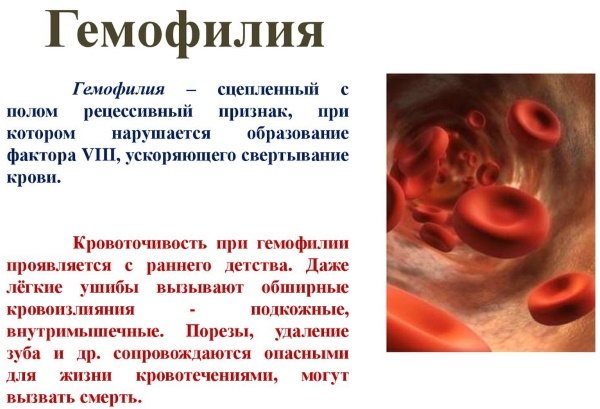
- diabetes;
- cirrhosis of the liver;
- Crohn's disease;
- hepatic or renal impairment;
- diseases of the respiratory system, which are accompanied by functional insufficiency in the work of the lungs;
- bronchial asthma;
- heart failure;
- the formation of pleural effusion;
- pulmonary heart syndrome;
- atherosclerotic lesions of the blood vessels of the lower extremities;
- encephalopathy with signs of impaired adaptive abilities to environmental conditions;
- thromboembolic disease;
- tachycardia of the paroxysmal type;
- previously suffered acute heart attack (if less than 12 months have passed since the onset of the attack).
The general list of contraindications for detoxification of the body from drugs depends on the method of blood purification, which is indicated for use in a particular clinical case.
It is important to remember that these restrictions on the use of the complex detox procedure apply only to patients whose internal organs can carry out the elimination of drugs in a natural way, and the use of medicines can lead to an exacerbation of concomitant diseases.
Ultra-Rapid Opioid Detoxification
Ultra-Rapid Opioid Detoxification (UFOD) is an effective way to quickly remove drugs from the patient's body.
The principle of using this method of blood purification is to carry out not only the removal chemical toxins formed after the breakdown of opioids, but also to save the patient from destructive withdrawal symptoms. The main difference between UBOD is the speed of the detoxification procedure, which lasts no more than 6-8 hours.
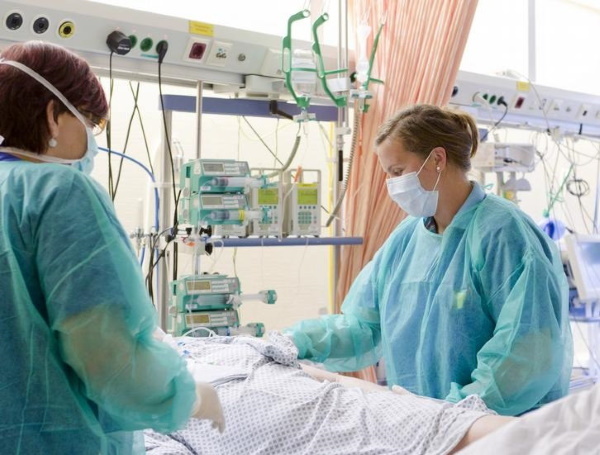
In this case, the patient is in a state of medication sleep under the influence of anesthetics. Ultra-rapid opioid detoxification is carried out only in a hospital setting under the supervision of medical personnel.
Training
At the stage of preparing the patient for the ultra-rapid opioid detoxification procedure, he is consulted with a psychiatrist and a narcologist.
After that, the patient will be required to pass the following types of tests:
- study of capillary blood for general indicators of its cellular composition;
- biochemical analysis of morning urine;
- microbiological examination of venous blood for the presence of infectious agents of HIV, hepatitis, syphilis and other serious diseases.
Depending on the general health of the patient, the presence or absence of concomitant diseases of internal organs and life support systems, the attending narcologist can prescribe the patient to undergo additional diagnostic methods. Before the start of AML, a person is in the general therapy ward.
Procedure step by step
Ultra-rapid opioid detoxification is carried out under constant supervision by an intensive care physician and anesthesiologist. The table below describes in detail a step-by-step set of actions aimed at the earliest possible elimination of drugs using the AML procedure.
| Step-by-step blood purification from opioid drugs | Characteristics of the detoxification process |
| Step 1. Anesthesia | At this stage of blood purification from narcotic drugs, the patient is taken to the intensive care unit, where he is injected with anesthetic drugs. The patient is in a state of deep medication sleep. All vital processes of his body are controlled by sensors of medical equipment. |
| Step 2. Opiate blocker administration | In order to neutralize the toxic effect of opiates, a potent drug, Naltrexone, is injected into the patient's body. This drug is delivered using intravenous infusion droppers. |
| Step 3. Removing the patient from the state of general anesthesia | After 6-8 hours of detoxification therapy with an opiate blocker, the patient is disconnected from the intravenous drip system, and then, with the help of special medications, they are returned to consciousness. |
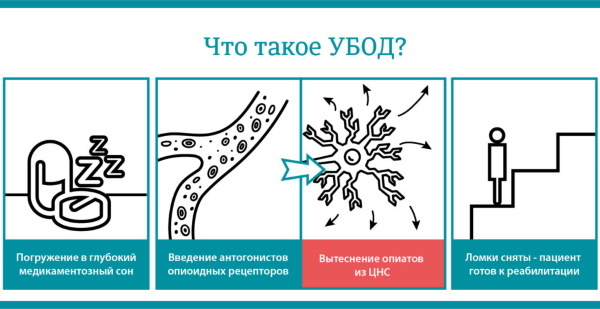
Upon completion of the AML procedure, the patient is transferred to his ward, where the next stage of his drug addiction treatment begins. At this stage, the toxic effect of opiates has been completely stopped.
Do's and Don'ts After
After an ultra-rapid opioid detoxification of the body, a person must stay in his ward for another 1-2 days. The patient is provided with complete rest, any physical activity is excluded.
The patient should sleep more, receive high-quality and balanced nutrition.
A person who has undergone detoxification therapy using the UBOD procedure cannot leave the walls of the clinic, take any psychotropic and intoxicating substances, medications.
How long will the result last
Ultra-fast opioid detoxification completely eliminates the negative effects of drugs on the human body, and also provides blocking of the receptors of the nervous system responsible for recognizing properties opiates.
Even if soon after detoxification the patient breaks down again, injects himself with another dose of the drug, he will not be able to experience the desired feeling of euphoria.
In the event that after 4-6 months a person tries to return to drug addiction, starts taking opioid drugs, then at this stage the action of the drug Naltrexone will already be discontinued.
The patient will again face the problem of dependence on psychotropic substances and the need to detoxify the body from these chemical components.
Advantages and disadvantages
It will be possible to remove drugs from the body quickly, provided that they seek medical help from a narcologist in a timely manner.
The following are the benefits of using ultra-rapid opioid detoxification of the body:
- due to the action of general anesthesia, a person does not feel any pain that is present during the acute phase of withdrawal;
- the total duration of drug excretion does not exceed 6-8 hours, which does not require a long stay in a hospital;
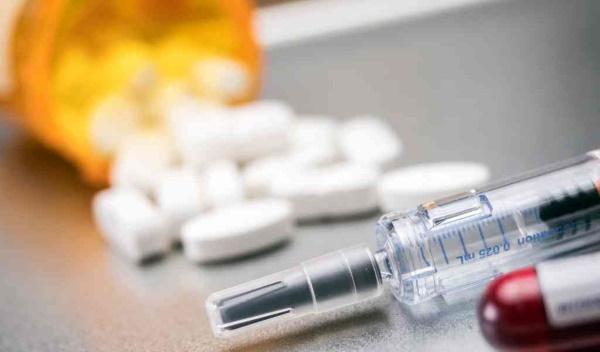
- the procedure allows you to achieve complete removal from the blood of all chemical compounds that are formed as a result of the metabolic breakdown of the drug;
- it is possible to get rid of the pathological craving for repeated drug use, and in case of receiving the next injection, a person does not feel that feeling of euphoria due to drug blocking of opioid receptors.
In order for the result of cleansing the body from narcotic substances using the UBOD procedure preserved as long as possible, the patient's will to start life without impact is necessary psychotropics.
The main disadvantages of this method of rapid detoxification include a large number of contraindications for the drug Naltrexone, the risk of side effects. Also, the UBOD procedure is used only to cleanse the body of opiates in the form of methadone and heroin.
Possible complications
Most of the potential complications of the AML procedure are associated with the risk of the following consequences:
- cardiac arrest of the patient due to the action of general anesthesia drugs and increased drug load on the cardiovascular system;
- feeling of heat in the tissues of the lower extremities;
- increased blood pressure;
- an increase in the volume of lymph nodes;
- feverish condition;
- decreased sex drive;
- deterioration in liver function;
- pathological changes in the structure of the skin, which correspond to stage 1 of frostbite;
- the onset of symptoms resembling ulcerative lesions of the gastrointestinal tract.
Complications of the UBOD procedure are directly related to the peculiarities of the action of general anesthesia on the human body, as well as the side effects of the drug Naltrexone. Most of the above conditions of the patient do not pose a threat to his life.
Hemodiafiltration
It is possible to remove drugs from the body quickly using the procedure of extrarenal blood purification from narcotic substances.
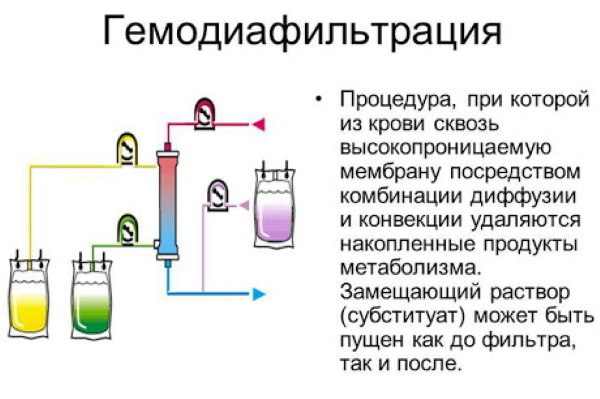
This method of detoxification of the body provides for the simultaneous filtration of blood and its purification using hemodialysis. Due to the resonance of the osmotic pressure, the effect of removing even the lowest molecular weight compounds of narcotic substances is achieved.
Training
Carrying out hemodiafiltration does not require special preparatory procedures. A patient who needs urgent blood purification from narcotic substances must be conscious, and also express a voluntary desire to receive medical assistance.
To perform hemodiafiltration, you will need the following consumables:
- an antiseptic in the form of an ethyl alcohol solution;
- low molecular weight heparin;
- saline 0.9% concentration in an amount from 1500 to 2000 ml;
- disposable syringes;
- sterile wipes and tampons;
- dialysis concentrate on a bicarbonate or acetate base;
- a set of needles for puncture of an arteriovenous prosthesis;
- dialyzer (contains a semi-permeable membrane that filters low molecular weight substances).
At the command of the attending physician or junior medical worker of the medical institution, the patient must go to the office for hemodiafiltration. After that, the process of purifying the blood from narcotic substances begins.
Step by step procedure
The process of removing drugs using hemodiafiltration takes place under the supervision of a nurse or attending physician. The table below provides a step-by-step procedure for removing psychotropic substances from a patient's blood.
| Step-by-step hemodiafiltration | Characterization of the detoxification process |
| Step 1. Connection to a hemodialysis machine | At this stage of detoxification therapy, the patient sits down in a chair. Then an employee of the hospital connects the system of the hemodiafiltration apparatus to the patient's general blood flow. For this, the method of blood vessel catheterization is used. |
| Step 2. Removal of narcotic and toxic substances | During the operation of the hemodialysis machine, the patient's blood is passed through a special membrane that interacts with the dialysis solution. The latter drug contains electrolytes in its composition, which make it possible to maintain the stability of the water-salt balance in the patient's body. |
| Step 3. Disconnecting the patient from the hemodiafiltration system | Upon completion of the procedure for purifying the blood from narcotic and toxic substances, the hemodiafiltration system is disconnected from the general blood flow of the patient. After that, the patient is transferred to his ward for further observation and medical care. |

The duration of the hemodiafiltration procedure depends on the concentration and type of drugs contained in the patient's blood.
What can or can not be done after
Immediately after completing the hemodiafiltration procedure, the patient must observe the following rules:
- stay in bed for 2-3 hours to ensure the body's full recovery;
- use ordinary drinking water without gases;
- exclude any physical activity;
- do not use drugs and drugs with psychotropic properties.
In the first 2-3 hours after the completion of the hemodiafiltration procedure, it is necessary to monitor blood pressure indicators. In case of tinnitus, severe headache, impaired coordination of movement, dizziness, it is necessary to report the deterioration of your health to the medical staff.
How long will the result last
Hemodiafiltration is a blood purification procedure that ensures the complete removal of narcotic compounds from the human body. This result persists until a person who is addicted to taking psychotropic substances does not reuse them.
In this situation, another hemodiafiltration procedure will be required. In order to minimize the risk of recurrence of intoxication of the body with narcotic substances, it is necessary to begin drug addiction therapy immediately after the completion of dialysis blood purification.
Advantages and disadvantages
You can quickly remove drugs from the body using dialysis solution and a filtration membrane that traps even the most low molecular weight chemical compounds.
The following advantages of the hemodiafiltration procedure are distinguished:
- allows you to quickly remove drugs from the body;
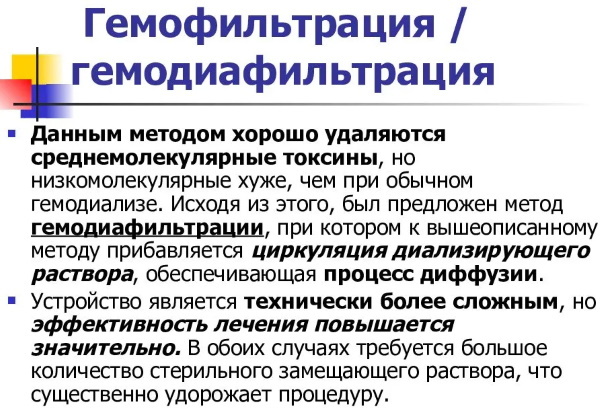
- not an expensive procedure;
- removes all types of drugs from the blood;
- does not require re-filtration of blood (the only exceptions are cases when the patient starts using drugs again).
The disadvantages of hemodiafiltration include the following factors:
- during the purification of the blood from psychotropic substances, the patient may experience withdrawal symptoms;
- carrying out this procedure requires that the patient is in an adequate condition, does not interfere with the actions of medical personnel;
- purification of blood from drugs using hemodiafiltration requires catheterization of large great vessels;
- there is a risk of infectious microorganisms entering the general bloodstream (for example, if the sterility rules were not properly followed during the preparation of the hemodialysis machine).
In the first 4 hours after the completion of hemodiafiltration, side effects of this procedure can be observed, most of which are associated with an imbalance in the electrolytic balance of the blood.
Possible complications
According to the results of blood purification from drugs using the hemodiafiltration procedure, the following complications and negative consequences for the patient's body may occur.
Scroll:
- attacks of severe headache;
- dizziness;
- increased blood pressure;
- dry mouth;
- feeling thirsty;
- physical weakness;
- blood poisoning with infectious microorganisms (in medical practice, there were cases when the hepatitis and HIV virus entered the patient's body through the hemodialysis machine);
- nausea.

Rapid elimination of drugs from the body involves the use of medicinal solutions and medical equipment, which allows you to remove toxins and chemical compounds formed as a result of the metabolic breakdown of psychotropic substances.
The use of ultra-rapid opioid detoxification makes it possible to purify the patient's blood in within 6-8 hours, eliminate the risk of withdrawal symptoms, and completely get rid of the drug dependencies.
The hemodiafiltration procedure is aimed at removing psychotropic substances of all types from the patient's body, as well as toxins that disrupt the functions of internal organs.
Video on how to remove drugs from the body
Detoxification (cleansing the body) for drug addiction:



